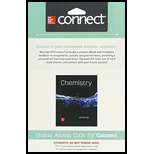
Interpretation:
In theantiatom of hydrogen, the electrical charges of the proton and electrons are reversed. The difference among the energy levels,
Concept introduction:
An atom consists of a positivelycharged nucleus and negativelycharged electrons revolving around it.
In an antiatom of hydrogen, only electrical charges of the constituent particles (i.e., antiproton and positron) are reversed to that of the hydrogen atom.
These electrons revolve in the orbits called energy levels or energy states.
Annihilation occurs when two particles collide with each other releasing energy.
Want to see the full answer?
Check out a sample textbook solution
Chapter 6 Solutions
Connect 2-Year Access Card for Chemistry
- 6.44 On what does the Pauli exclusion principle place a limit?arrow_forwardWhen the Sojourner spacecraft landed on Mars in 1997, the planet was approximately 7.8 107 km from Earth. How long did it take for the television picture signal to reach Earth from Mars?arrow_forwardUsing the Heisenberg uncertainty principle, calculate x for each of the following. a. an electron with v = 0.100 m/s b. a baseball (mass = 145 g) with v = 0.100 m/s How does the answer in part a compare with the size of a hydrogen atom? How does the answer in part b correspond to the size of a baseball?arrow_forward
- The space probe Pioneer 11 was launched April 5, 1973, and reached Jupiter in December 1974, traveling a distance of 998 million km. How long did it take an electromagnetic signal to travel to Earth from Pioneer 11 when it was near Jupiter?arrow_forward6.20 When light with a wavelength of 58.5 nm strikes the surface of tin metal, electrons are ejected with a maximum kinetic energy of 2.691018 J. What is the binding energy of these electrons to the metal?arrow_forwardThe second is defined as the time it takes for 9,192,631,770 wavelengths of a certain transition of the cesium-133 atom to pass a fixed point. What is the frequency of this electromagnetic radiation? What is the wavelength?arrow_forward
- An electron in a hydrogen atom in the level n = 5 undergoes a transition to level n = 3. What is the frequency of the emitted radiation?arrow_forwardCalculate the mass of the deuteron given that the first line in the Lyman series of 1H lies at 82 259.098 cm−1 whereas that of 2H lies at 82 281.476 cm−1. Calculate the ratio of the ionization energies of 1H and 2H.arrow_forwardAn effective treatment for some cancerous tumors involves irradiation with "fast" neutrons. The neutrons from one treatment source have an average velocity of 3.3×107 m/s. If the velocities of individual neutrons are known to within 2.0% of this value, what is the uncertainty in the position of one of them?arrow_forward
 Chemistry: The Molecular ScienceChemistryISBN:9781285199047Author:John W. Moore, Conrad L. StanitskiPublisher:Cengage Learning
Chemistry: The Molecular ScienceChemistryISBN:9781285199047Author:John W. Moore, Conrad L. StanitskiPublisher:Cengage Learning Physical ChemistryChemistryISBN:9781133958437Author:Ball, David W. (david Warren), BAER, TomasPublisher:Wadsworth Cengage Learning,
Physical ChemistryChemistryISBN:9781133958437Author:Ball, David W. (david Warren), BAER, TomasPublisher:Wadsworth Cengage Learning,
 ChemistryChemistryISBN:9781305957404Author:Steven S. Zumdahl, Susan A. Zumdahl, Donald J. DeCostePublisher:Cengage Learning
ChemistryChemistryISBN:9781305957404Author:Steven S. Zumdahl, Susan A. Zumdahl, Donald J. DeCostePublisher:Cengage Learning Chemistry: An Atoms First ApproachChemistryISBN:9781305079243Author:Steven S. Zumdahl, Susan A. ZumdahlPublisher:Cengage Learning
Chemistry: An Atoms First ApproachChemistryISBN:9781305079243Author:Steven S. Zumdahl, Susan A. ZumdahlPublisher:Cengage Learning





